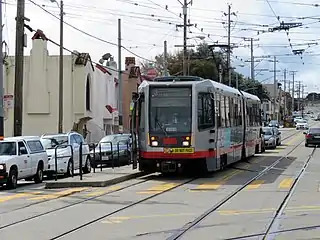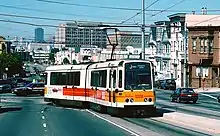J Church
J Church is a light rail line in the Muni Metro system, and is operated by the San Francisco Municipal Railway.
| J Church | |||
|---|---|---|---|
 | |||
 An inbound J Church train boarding passengers at San Jose Avenue and Ocean Avenue in March 2018 | |||
| Overview | |||
| Owner | San Francisco Municipal Transportation Agency | ||
| Locale | San Francisco, California | ||
| Termini | Church and Duboce Balboa Park station | ||
| Stations | 26 | ||
| Service | |||
| Type | Light rail/streetcar | ||
| System | Muni Metro | ||
| Operator(s) | San Francisco Municipal Railway | ||
| Rolling stock | Breda LRV2/LRV3, Siemens LRV4 | ||
| Daily ridership | 15,500 (2019)[1]:47 | ||
| History | |||
| Opened | August 11, 1917[2] | ||
| Technical | |||
| Track gauge | 4 ft 8 1⁄2 in (1,435 mm) standard gauge | ||
| Electrification | Overhead lines, 600 V DC | ||
| |||
Operation
J Church begins service at 5 a.m. weekdays, 6 a.m. Saturdays and 8 a.m. Sundays and continues until 12:15 a.m. every night. Daytime headways are every 10 minutes, and 12 minutes on weekends.
History
.jpg.webp)
Track work on the J Church line was largely completed in 1916. The service from Church and 30th Street station to Market Street and Van Ness Avenue started on August 11, 1917.[3][2] Service went further along Van Ness Avenue to Pine Street on August 29, 1917; service to Pine Street was discontinued on May 31, 1918, with service along Market Street to the Ferry Building the next day.[4] The new Transbay Terminal became the inner terminus for every other streetcar line on January 15, 1939, with all service going there after January 1, 1941.[4]
Light rail operation
As part of the creation of the Muni Metro system, streetcar operation switched to light rail operation in 1981 – the last line to do so.[5][6] While many streetcar lines switched to bus lines after World War II, the J Church avoided this due to the private right-of-way it uses between 18th Street and 22nd Street.[7]
Extension to Balboa Park

The outer end of the line was originally at Church and 30th Streets. It was where streetcars used a triangle of railroad track to turn back. Studies to further the line from its southern terminus had been made in the 1920s[3] and 1970's.[8] In 1990–91, the tracks were extended to the Balboa Park BART station and the Metro Center (Muni light-rail base), giving J-line cars a much shorter connection to the yard than before. The extension opened on August 31, 1991. But the new section was used only by light rail cars starting or ending their runs;[9] all-day J-line service was not use the new tracks until June 19, 1993.[10][11]
References
- "Short Range Transit Plan: Fiscal Year 2019 - Fiscal Year 2030" (PDF). San Francisco Municipal Transportation Agency. December 2019.
- "Happy Centennial, J-Church". streetcar.org. Market Street Railway. 11 August 2017. Retrieved August 15, 2017.
- Menzies, Jeremy (9 August 2017). "Hooray for the J: 100 Years on the J Church". sfmta.com. San Francisco Municipal Transportation Agency. Retrieved August 15, 2017.
- Stindt, Fred A. (October 1990). San Francisco's Century of Street Cars. p. 186. ISBN 0961546514.
- Template:Muni Chronology
- McKane, John; Perles, Anthony (1982). Inside Muni: The Properties and Operations of the Municipal Railway of San Francisco. Glendale, CA (US): Interurban Press. pp. 189–190. ISBN 0-916374-49-1.
- Template:People's Railway
- "Copy of Map of Possible J Church Line Connection to Ocean Division via Bernal Cut for Muni Metro". SFMTA Photography Department & Archive. February 29, 1972. Retrieved November 12, 2018.
- "World News [regular news section]". Modern Tramway. UK: Ian Allan Publishing. December 1991. p. 430. ISSN 0144-1655.
- Springirth, Kenneth C. (2015). San Francisco's Magnificent Streetcars. Fonthill Media. p. 47. ISBN 978-1-63499-001-1.
- "World News [regular news section]". Light Rail and Modern Tramway. UK: Ian Allan Publishing. September 1993. p. 249. ISSN 0964-9255.